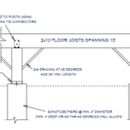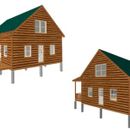Insulation below the camp
OK — I don’t know what I don’t know, and basically I need advice on how to insulate the underneath or a camp — we live in Upstate NY, and we are building a camp on piers using cement tubes — we are torn on how to keep things from freezing. I know we need some type of barrier to keep all the unwanted guests out from under the camp, so some type of skirt needs to be added, but do we put insulation on the inside of those, to keep thins “warm” or do we add insulation to between the floor joist and then put OSB up to keep it enclosed — or a combination of both or all or what? We plan on having running water — so any help or suggestions will be appreciated.
Thanks
AJP
GBA Detail Library
A collection of one thousand construction details organized by climate and house part











Replies
Is this camp going to be actively heated?
What things are you trying to keep from freezing?
Describe what sort of structures (if any) are going to be above the floor joists.
As far as the heating, it will not be full time, more of a glorified hunt/snomobile camp with as much use as possible. I am talking about water lines. I attached the pier and as far as what is about the joist, well the living, sleeping, and kitchen areas.
AJP,
It sounds like your camp will have a cold floor. This article outlines how you can address that type of assembly: http://www.finehomebuilding.com/2012/03/08/how-to-insulate-a-cold-floor
There is still the issue of protecting your water lines.
So, the drawing shows just a platform on piers, no structure on top?
Unless it's actively heated you'll have to drain the plumbing to avoid freeze up.
This is what is going on top -- I am not sure what you are looking for -- it will be a 30x26 camp, kitchen, bathroom, bedroom with a loft
AJP,
Here is a link to an article that tells you how to insulate a floor: How to Insulate a Cold Floor.
Here is a link to an article that discusses the pros and cons of the "crawl space vs. skirt" dilemma: Crawl Spaces vs. Skirts.
Keeping your water pipes from freezing requires either (a) Keeping the place heated all year round, and including heat for a conditioned crawl space, or (b) Draining all of your plumbing and putting antifreeze in your toilet bowl.
Thanks Martin -- I seen this article and that is what sparked my post -- thanks --
Martin, can you elaborate on your 2012 article? Two things really caught my eye that I can't get my brain around. First, the idea that if your insulation is not in contact with the floor, "the floor assembly has an R-value of 0". If the assembly is well sealed against air infiltration, why would not the top of the insulation gravitate toward the floor temp? In fact, I've seen some wall schemes that put all the insulation on the outside of the sheathing - nothing in contact with the drywall. Since the "perfect wall" articles suggest that a floor is just a wall turned sideways... well, I'm lost. Second, the 2012 article comment "Fiberglass batts are the worst type of insulation for this application"... I don't understand why - they are fine for attics, right? Again, we have to assume sheathing below the joists and that the entire joist assembly is sealed against air leakage. So, why not fiberglass and why not let it lay on the sheathing, rather than up tight against the floor? I appreciate your thoughts. Thanks much, Mark
Mark,
Q. "First, the idea that if your insulation is not in contact with the floor, 'the floor assembly has an R-value of 0.' If the assembly is well sealed against air infiltration, why would not the top of the insulation gravitate toward the floor temp?"
A. If the rim joist at the perimeter of the ceiling (floor) assembly is perfectly air-sealed, along with the garage ceiling under the fiberglass batts, you're right -- batts that slump away from the subfloor above still have some R-value. Such installations are very rare, however. Most rim joist areas leak a lot of air, and so do garage ceilings, especially at electrical boxes -- so these floor assemblies are usually raceways for outdoor air. The fiberglass batts that fall away from the subfloor aren't doing much.
Q. "'Fiberglass batts are the worst type of insulation for this application'... I don't understand why - they are fine for attics, right?"
A. No. Fiberglass batts are terrible for attics. You want cellulose for your attic floor. If you install fiberglass batts, you're likely to have voids and compression, as well as hidden air pathways. For more information on this topic, see Installing Fiberglass Right.
Thanks, Martin. Wow, I thought I was starting to have this all figured out... appreciate your clarifications.